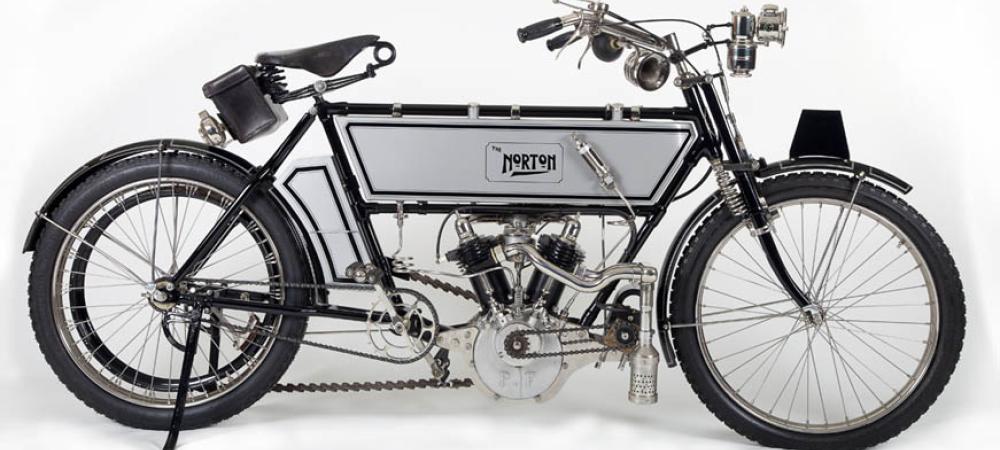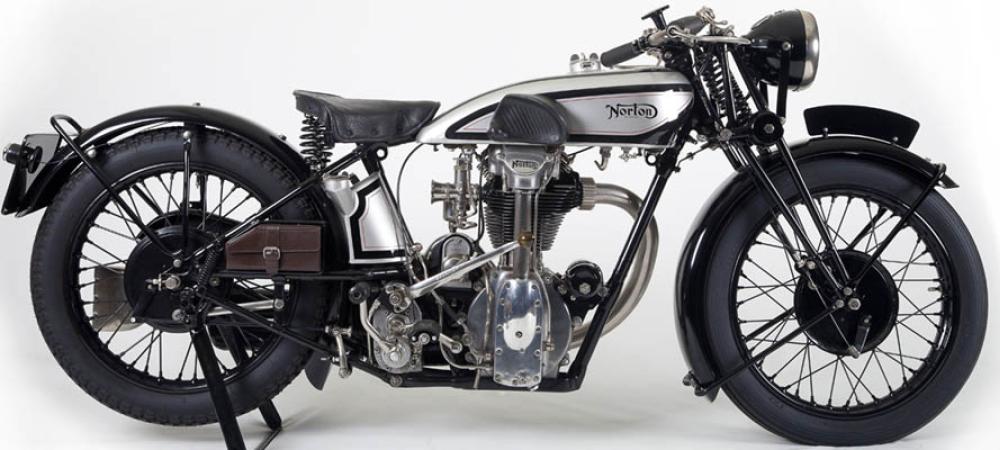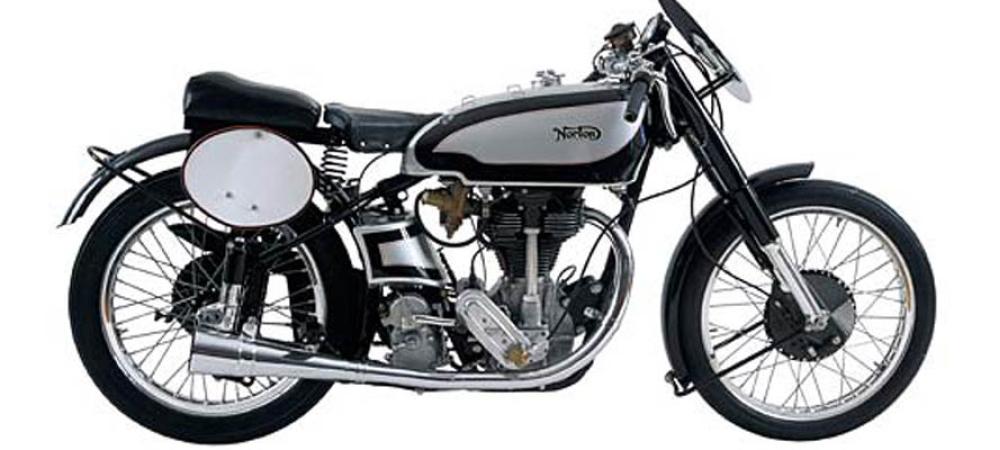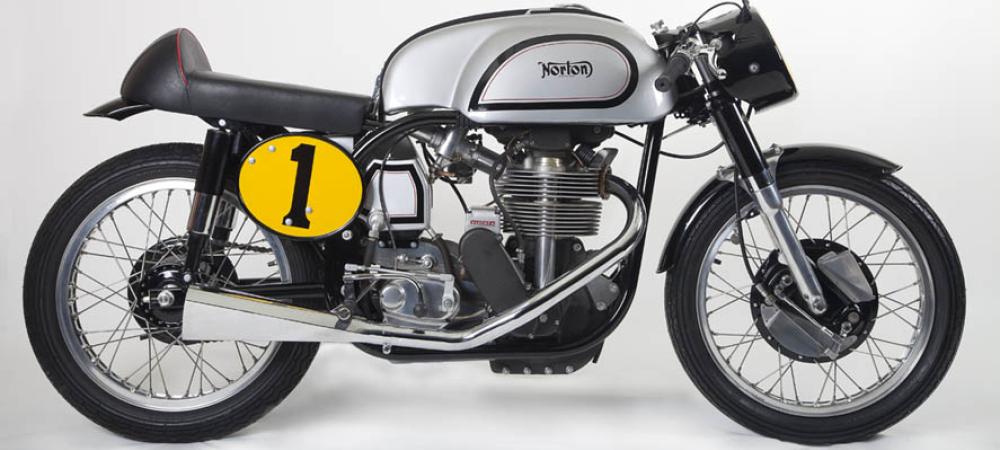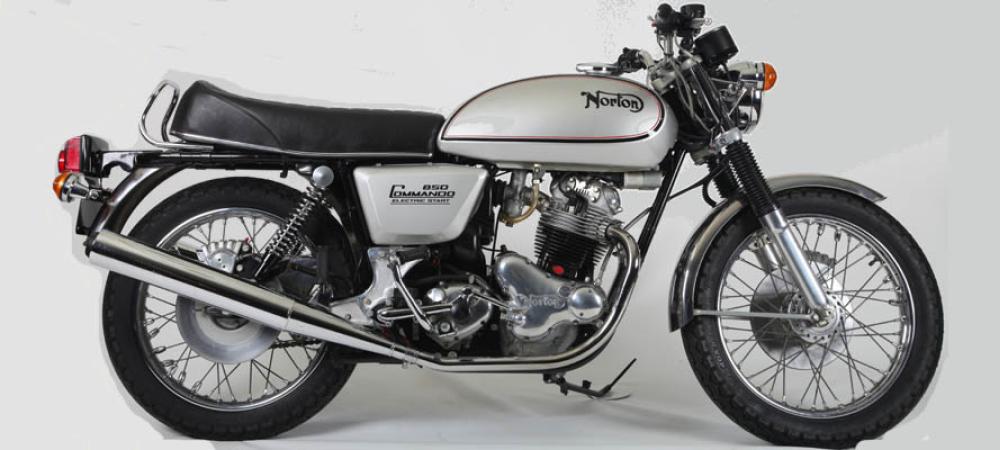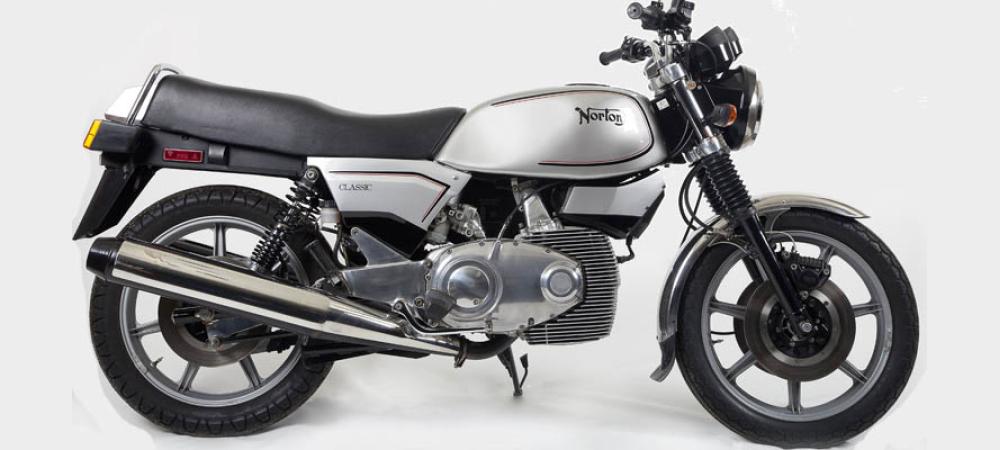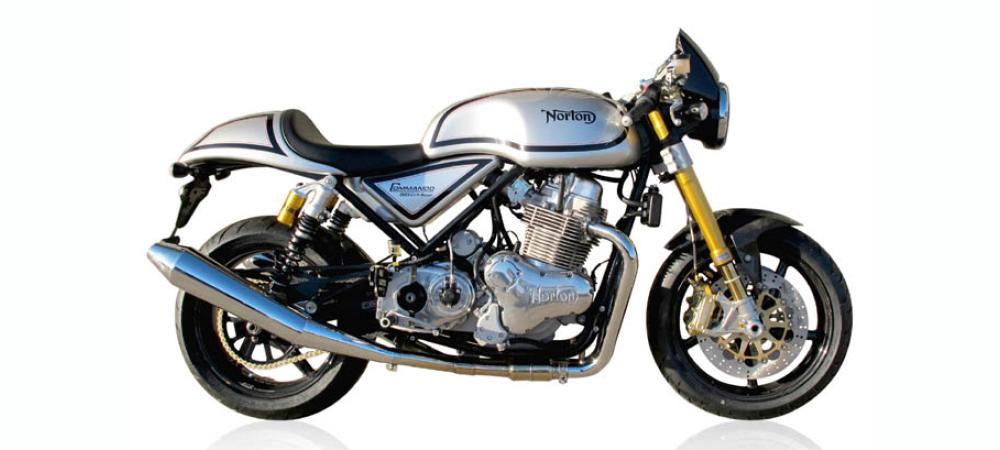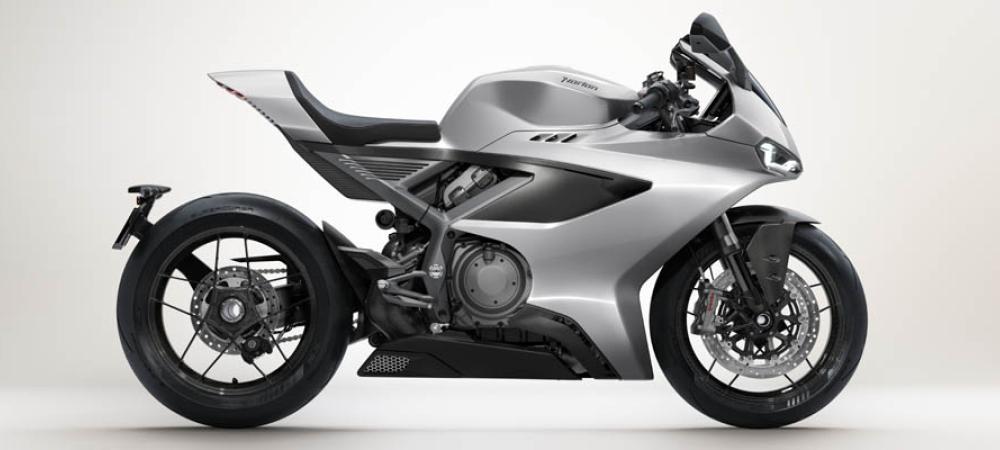THE NORTON LIGHTWEIGHT TWINS
The Norton Jubilee (and its offspring, the Navigator and Electra) deserves its niche in the history of the British motor cycle industry, as it was the last all-new motorcycle engine design to emerge before the advent of the Rotary. The Jubilee's dates are 1958-66, the Navigator ran from 1960-65 and the Electra from 1963-65. No lightweights survived the great AMC crash of 1966.
The 250cc Norton Jubilee was launched on the public at the Earls Court show in November I958. "Go gay with the Norton Jubilee" is the buy line on the front cover of the 6th. November 1958 issue of The Motor Cycle. Who could have foreseen the innuendo then? The new machine was promoted as "the most modern motor cycle of today", featuring a stylish rear fairing enshrouding the ancillaries, unusually comprehensive mudguarding and finished in modern two-tone trim. The colour choice was Red, Green or Blue and Dove Grey.
It was Norton's attempt to get at the 250cc market and the learner motorcyclist, so ensuring brand loyalty as he moved to more powerful machinery. Triumph had the Cub, BSA had the Bantam and C15, AJS and Matchless had their lightweight singles, AMC had some two-strokes, but the Jubilee was the only four-stroke twin.
If we look back at the advertisements of the time, we find the Jubilee was being sold at a premium price, perhaps hoping to give it an aura of exclusivity. For example, in the January 22nd. 1959 edition of Motor Cycling we find the Triumph Tiger Cub is £149 14s. 0d., the BSA is £172 0s. 0d., Francis Barnett's 250 Cruiser 80 is £185 5s. 0d., the AJS Model 14 is £196 9s. 8d., Ariel's Leader is £209 11s. 7d., and the Jubilee is £215 16s. 4d. (all in real money).
The Designer
The story begins in April 1955. On that date, Bert Hopwood rejoined Norton as a Director, having spent a 7 year interlude at BSA. When he left Norton in 1948, just prior to the launch of the Dominator (which he had designed), Hopwood was already thinking about small Nortons, based on a 125cc OHC single cylinder module. This would have given Norton a 125 single, 250 twin, 500 four and with Doug Hele's help, maybe even a 375 triple. As it was, he came back to a company whose main product was the same (largely unchanged) Dominator, being produced at a rate of 180-200 per week.
Hopwood recognised the need to expand the model range immediately, and the next machine was to be a 250cc twin. There exists a 250 single prototype at Beaulieu, dating from 1953, but this project was never pursued.
Although Hopwood had some radical ideas for the design of the new twin, what emerged finally as the Jubilee was an amalgam of AMC products. The frame, forks and wheels were straight from the Francis Barnett Cruiser, the novel rear enclosure was supplied by another sister company, Clarendon Pressings, the gearbox of the unit construction motor was identical to the AMC 2 stroke Piatti engine, as well as the AJS and Matchless 'lightweights'. The only new part was the engine, itself a compromise of what Norton could do for the money, rather than what the designer had first intended. Such was the way of British industry at the time.
The Engine
The heart of the engine is a massive drop forged, one-piece crankshaft, with an unusual, large diameter (7"), integral central flywheel, which runs between the cylinders. The crank is supported, Dominator style, in massive main bearings, roller on the drive side and ball on the timing side. Although these bearings have the same dimensions as the Dominator items, they are not the same in one important area. The lightweight Norton bearings have a large chamfer at the journal/crankcheek join to allow for the radius at this point.
In the absence of Jubilee bearings, a machine shop should be able to grind Dominator bearings to suit, This problem with the bearings was not properly understood even at the time when these machines were popular, and the author has seen many engines that were damaged by having Dominator bearings fitted in error. The results are usually fatal.
The crankshaft contains within it a hollow chamber, which is used as a sludge trap. This should be cleaned out whenever the engine is being reconditioned, and is accessible by removing a small aluminium plug located at one end. Usually this plug will have been centre punched into place, so drilling it out is the only option. When replacing it, be sure to centre punch it so that it will not unscrew on its own.
The conrods are in high-duty light alloy and employ plain big end shells identical to the 500 and 600cc Dominators. The small end is unbushed. Jubilee and Navigator rods are not interchangeable.
The cylinder barrels are separate iron castings, spigotted deeply into the crankcase and with five cooling fins visible on the upper half. Hollow, flat-base cam followers, free to rotate, run in cast iron guides which are pressed into the barrels. These guides are extremely short and have to put up with a sideways thrust, and it comes as no surprise that the stems of the followers eventually wear into a barrel shape. A lot of the 'tappety' noise of these models can be traced to this component. The guides themselves seldom wear out.
The Navigator and Electra employ a one-piece cylinder block, similarly deeply spigotted into the crankcase.
Orthodox, split skirt pistons with flat crowns and valve cut-outs are employed on the Jubilee and Navigator. The Electra however uses pistons without a split skirt, but with radially disposed holes just under the oil ring, to lubricate the bores.
The cylinder heads are two separate castings of aluminium alloy, which are each clamped down to the crankcase with six long studs. An unusual feature of the cylinder head is the valve included angle which at 42° is much narrower than normal. It is a legacy of the original design, which talked of a one-piece head and barrel, and would have allowed the valves to be inserted from below.
Although we would look now at such a design as retrograde, the reason given at the time for abandoning such a proposal was that "motorcyclists liked nothing better than decoking the cylinder head on a Sunday morning". That remark is attributed to Donald Heather by Bert Hopwood, who further goes on to say: "poor, hapless little souls, no wonder they went Japanese".
Tiny 3" pushrods operate the rockers, each of which is housed under its own domed light alloy cover. Rocker adjustment is by means of an eccentric spindle, and is maintained by a small clamp bolt. During the life of the Jubilee motor, the clamp bolt was made larger, as the earlier version could get tired and let go. The result was an instant opening of the valve gap to maximum, and you lost that cylinder. Usually, no damage was done, and a new clamp bolt returned things to normal.
Lubrication
The lubrication system follows the Dominator pattern, having the same 3-start gear type oil pump feeding oil into the end of the crankshaft via a gallery in the timing cover. The cylinders and cams are splash fed from the oil that emerges past the big ends. The oil then collects in the sump, drops through a wire gauze, whence it is pumped back up to the tank at double speed. A bleed is taken off from the return to the tank, which, by means of a constriction in the tank, sends oil up to the rocker gear. From there the oil drains back down to the sump via the push rods and cam followers, also lubricating the drive side cam bushes.
Here it is worth repeating a modification for the Dominator, often suggested by none other than John Hudson (ex-Service Manager at Norton). To improve the oil flow to the rocker gear, simply substitute the original return pipe adapter (in the bottom of the oil tank - Part No. 19380) for the equivalent item from a De Luxe Jubilee (or Navigator) (Part. No. 22148). This modification works because the Jubilee item has a smaller orifice, and more oil is therefore directed to the rockers.
The Jubilee, in common with all Nortons built before the Commando 850 Mk.lll, does not possess an anti-drain valve in the oil feed to the engine. In practice this means that some oil inevitably finds its way to the sump while the bike is parked. This is not usually a problem, except that you have to be aware of it, and you should let the bike run for a minute or two before checking the oil level. Failure to do so normally means a slippery back wheel, as the oil in the sump is pumped back up and then out through the overflow.
The Electra was the first Norton to be fitted with a 6-start oil pump worm, followed by the Jubilee and Navigator at No. 106838. The big twins did not get the larger capacity pump until No. 116372.
The Launch
The Jubilee was so named to celebrate Norton's Diamond Jubilee, marking 60 years since 'Pa' Norton started his business. The new Jubilee was first shown to the press on 6th. November 1958 and reviewed in both The Motor Cycle and Motor Cycling (known affectionately as The Blue 'un and The Green 'un respectively) on that date, and to the public at 10 a.m. on Saturday 15th. November 1958, when the doors opened at Earls Court.
The Factory Records
The NOC has acquired copies of factory records for this period, so it was with some interest the author studied the gestation and birth of the newcomer. Development machines do not appear in the records, as they fell outside of the numbering system. The first Jubilees recorded are a pair made in October 1958. They were No. 79819 (Red and Dove Grey) and No. 79820 (Blue and Dove Grey) and appear in the records in the middle of a batch of other machines. The first was sold to Philpots of Ramsgate and the second one went to NoMo in Berne in November 1958, well before mass production commenced. One suspects that they were the first dealers to sign an order (at the show?).
On 6th. November 1958, 4 Jubilees are shown (Nos. 79866 to 79869) and presumably went to Earls Court. Its not recorded what subsequently happened to them although Frame No. 79867 now resides in the author's shed. Then there were 2 more built late in January 1959 (Nos. 79946 and 79947). These were both Green and Dove Grey and were destined for the Development Dept. The engine from the latter machine also now resides in the author's shed. . In early January 1959, 6 machines were assembled (Nos. 80751 to 80756), followed by a batch of 40 (Nos. 80950 to 80989) in February 1959. The oldest complete survivor, No. 80982, is from this batch and at time of writing resides in Leigh upon Mendip. Then towards the end of February a small batch of 14 bikes (Nos. 81206 to 81219) were made, 9 in Green and Dove Grey and 5 in Blue and Dove Grey. Four months had passed now since the Jubilee was first shown to the public and yet no large batch had been manufactured. In fact only 68 bikes had been built since the launch up to the end of February 1959.
Pre-Production Testing
During November 1958, 3 Jubilees were taken to North Wales by John Hudson (who crashed on his way to the test site, and sustained a badly sprained wrist), Dennis Greenfield, John and Bill Harris, with the intention of conducting a three week destruction test. Nothing significant (apart from gearbox problems on one bike) broke. The bikes involved were, one suspects, Nos. 79819 and 79820 (the first two) and a development machine, with a different shaped tank badge. This is probably the same machine we see in various write-ups of the time.
Production Starts
The first production run, from 3rd. to 14th. March 1959, consisted of 127 machines (Nos. (81416 to 81542), and the first one (XOH 147) was destined for a road test in Motor Cycling which was published on 12th. March 1959. Engine No. 81458 surfaced in Wiltshire via, it is believed, the late Bob Collier (ex-Sales Manager at Bracebridge Street, and inveterate collector/ modifier/ ISDT'er).
The next batch was 300 bikes (Nos. 82138 to 82437) from 16th. April until 20th. May 1959, and the third batch was also 300 machines (Nos. 82822 to 83121), which took the factory a month to make, from 25th. May to 22nd. June 1959. From this date, production ran smoothly in between batches of Dominator, ES2s, etc.
Teething Troubles
The fact that the three machines taken for testing in North Wales survived 3 weeks of abuse did not prove that the new 'baby' was going to be flawless, In fact, very quickly, a major weakness showed up, which took some time to fix. Somewhere in the drawing office, or in purchasing, someone got it wrong, and the incorrect material was specified for the crankshaft (Meehanite when it should have been nodular iron), The result, sadly, was a series of broken cranks, and as about 2000 of them were made, one can imagine that warranty replacements were no stronger than the originals. The author suspects that the extra large radius at the crankcheek was introduced at this point. This made the crank stronger, which, along with the change of material, cured the problem.
Developments
In October 1960, a new version of the Jubilee was announced, shorn of all the rear enclosures and possessing a larger (6") Wipac headlamp. The new version was called the Standard model and the faired version became known as the De Luxe. With the new version came a restricted colour choice. The De Luxe model would now be Blue and Dove Grey, whilst the new standard version was Red and Dove Grey. Green appears to have been dropped from the choices available and the author has never seen one in that colour.
In late 1963, a modification was carried out at Plumstead to the top of the cylinder. Previously, the cylinder barrel had a 2mm tall spigot which protruded into a recess in the cylinder head. At first on the Electra, and then gradually across the whole range of Nortons, this spigot disappears. Careful measurement on several Navigators and Electras confirms that, instead of simply removing the spigot, the factory allowed the cylinder to be 2mm taller. Consequently, the cylinder heads had 2mm shaved from them at the joint face. Beware of these differences when shopping around.
The author cannot confirm if the same change occurred to the Jubilee, but a change of compression ratio quoted for 1965 seems to indicate that some changes did indeed occur.
The Jubilee came to the end of its life amidst the financial ruins of the AMC group in 1966, but not without one last gasp. None had been made since August 1965 (Nos. 113969 - 114068) and then it was only 100 bikes, but in May 1966 a fresh batch was made - all for the one customer.
That customer was Claude Rye of Fulham, London, and he took delivery of all of the last 50 Jubilees (Nos. 117776 - 117825). The April 1967 issue of Motorcycle Mechanics carries an advert for Claude Rye, offering these very bikes at the bargain price of £179 19s. 6d. Compare this with its launch price of £215 16s. 4d. nine years before, and the Honda 250 in the same advert at £199 19s. 6d. Just twenty pounds more would buy you a fast, electric start Japanese bike. The end had truly arrived.
The Navigator
In November 1960 came the 350cc Navigator, bigger brother to the Jubilee. It was the sensation of the show. A new 350 twin from Norton, a production bike that would pull nearly 90mph, with impeccable steering, and very powerful brakes. It was also to be offered in De Luxe form as the Jubilee had been, and in the new 'Standard' version, minus all the rear enclosures.
While the Jubilee was being laid out in design, thought was given to enlarging the design to 350cc, so when the time came to do it, the task was relatively simple. The new engine size would be 63mm x 56mm (compared with 60mm x 44mm for the 250) bore x stroke. The crankshaft material was changed to forged steel as there was less overlap from main bearing to big end journals. The conrods were slightly longer at 45/16" centres, and wider at the little end. The cylinder barrels became one block, though the heads, whilst different, remained separate. The differences were to allow for the larger spigot on top of the barrel, and for the larger manifold. The valve gear remained the same, except that Navigator pushrods were longer.
The primary drive side and gearbox are identical, with the only change being a 19T gearbox sprocket fitted (compared with 17T on the Jubilee). Also, the gearbox mainshaft was changed on both models, removing the step down at the clutch end, which might have caused problems handling the Navigator's extra power.
At the back wheel the only change was to the sprocket, giving 52T (Navigator) and 55T (Jubilee). The most visible difference between the Jubilee and the Navigator is the front end. On the new model the famous 'Roadholder' forks were fitted, as well as the Norton front wheel with its huge 8" front stopper. There were several benefits to be gained from having a 'proper' front end, namely better braking, damping, and looks, There are three differences between Navigator front forks and the equivalent Dominator items:-
1) Springs. Navigator were softer and were coded green.
2) Headlamp. Navigator item was 6" Wipac against 7" Lucas.
3) Head race bearings. Navigator uses distinctive cups and cones.
The Electra
In January 1963 came the last of the Norton lightweights. Its reason for being came from the States. There, Norton sales were handled by the Berliner Corporation, and Joe Berliner, facing competition from Japanese (electric starting and indicating) 250s and 350s, could not sell Jubilees or Navigators. At his own expense he 'beefed up' a Navigator and proceeded to 'sell' it back to Norton. In fact he 'sold' the idea to the board of AMC, who built the Electra wholly at Woolwich, with minimal input from Bracebridge Street, as production was being moved down to the AMC factory anyway. A legacy of this is that the engine frame numbering system on the Electra falls outside the Norton system. Likewise no mention of the Electra can be found in the Norton factory records.
In fact, Joe Berliner built two electric start Navigators. He increased the engine size to allow for the extra power needed because of the extra weight, by boring and stroking the motor. The new dimensions were 66mm x 58mm giving a swept volume of 397cc, hence it was designated a 400. In practice, production bikes used a version of the Navigator crankshaft (with thinner flywheel) to give engine dimensions of 66mm x 56mm and a capacity of 383cc. So the ES400 Electra is a little liar just like the 850 Commando, which is only 828cc).
The starter motor was the Lucas M3, as developed for the Triumph Tigress scooter and used on the Trident Tl60, and it is a powerful 4 brush motor, let down only by the small batteries originally used, With a pair of modern batteries, the Electra should start every time on the button even from cold.
Several other features distinguish the Electra from its smaller brothers. The most visible one is the adoption of the bolt-up rear wheel hub from the Dominator, laced to an 18 inch rim.
The next change was in the adoption of 12 volt electrics, with two batteries. One battery is in the normal position, in the toolbox, whilst the other resides in a special carrier under the seat. As we are looking under the seat, the next difference to the Navigator can be seen. It is the voltage control box, which with the differently wound alternator, keeps the batteries charged by cutting alternator coils in or out as required, much like the old CVC units used to do with dynamo electrics.
Another change was to the gearbox. Up to now, the Jubilee and Navigator had shared their gearbox internals with the other AMC lightweights. But the Electra was destined to receive a re-designed gearbox, which according to Tony Denniss, had been intended for the new Matchless G4 (a bike that never saw the light of day). This gearbox found its way into the Jubilee and Navigator models, as the older crankcases got used up. The change occurs at Navigator No. 106838, and from then on, only the new gearbox was used.
n.b. the author has since seen blank castings at Sammy Miller's museum in Hampshire that look like they are from the Electra gearbox, yet they are described as being part of a ‘racing gearbox’. More research needed!
The Gearbox
As stated above, the early Jubilees and Navigator shared a common gearbox (with detail differences) with all the other AMC lightweights. The gearbox itself is robust enough, but several points need to be watched.
The most important one is to maintain the oil level. Of the two pints used, the first pint just lubricates the selectors and cam. The design is such that the gearshafts are one behind the other, and the second pint of oil is needed just to reach the cogs.
The next point to watch is the layshaft bush adjacent to the sleeve gear. This has a tendency to pick-up on the layshaft, and spin in the case, which blanks off the oilway and compounds the problem. It happens when the oil level drops and you ignore this warning at your peril.
The author would strongly advise any lightweight owner, whose machine is numbered before 106837, to inspect this bush. If caught in time, the area needs to be degreased (methylated spirit can be used) and bearing retainer Loctite (or similar product) utilised to replace the bush, taking care to line up the oil way. The product named above can reputedly take up to 5 thousandths of an inch in play. Any more than that and specialist advice needs to be sought.
The last point to watch is the layshaft fixed (4th) gear. It can be installed either way round, but there is only one right way. If fitted wrongly, only half the teeth are in mesh and consequently wear very rapidly. The flush face of the gears should go against the crankcase wall.
On machines that have covered a high mileage, jumping out of first gear can occur. The cure for this is to insert a shim between the kickstart and the layshaft first gear to take up excess end float.
The gearbox introduced at No. 106838 tackled the layshaft bush problem by pegging it in place. You still need to ensure that the oil level is maintained, and to assist the owner a level plug has been added to the outer cover. Indeed, this level plug helps to identify this gearbox. You still need to take care that the layshaft fixed gear is fitted correctly. This gearbox also has a weak spot in that the kickstart pawl is very small and can wear rapidly. No parts are interchangeable between the two versions.
The Frame
The Jubilee frame is unusual, in that it comprises several bolted up sections. This makes repairs relatively simple to effect, but sending the frame away to be stove enamelled can be a logistics problem keeping track of all the separate components. The De Luxe and Standard models used a slightly different frame from each other.
The De Luxe frame has a tooltray under the seat, with the centrally mounted oil tank filler to one side. The seat was held down at first by Terry clips acting on extensions of the shock absorber bolts, but from 1960 on, a single Dzus fastener held the seat down to the tail portion of the full enclosure. The battery sat on a platform on the offside of the machine, and there were three mounting points on each side for the rear enclosure.
The Standard frame differs in one way; the frame bracing strut running from the swinging arm to the top tube is welded into place, whereas on the De Luxe it is bolted in place. The battery/toolbox is now on the nearside, with a matching oil tank on the offside, and a small styling panel wrapped around them behind the carburettor. The seat was clamped into place by long studs through the top of the rear shock absorber mounting.
The Electra frame differs in several respects. As the gearbox internals changed, so too did the crankcase castings. The lower gearbox mounting point moved to such a position that the mounting stud could no longer be inserted from the side, but had to be installed in the motor before it was introduced to the frame. To facilitate this, the corresponding stud mounting holes in the frame are slotted. This also applies to the Jubilee and Navigator after No. 106838.
Another Electra difference to the frame, was the addition of bracing struts fitted under the petrol tank to give extra support to the headstock, because of the additional weight carried. These braces, when fitted, interfered with rocker cap removal and it was not unusual to see evidence where previous owners had removed metal from the braces, in order to be able to get at the tappets.
As the Electra used the bolt-up Dominator rear wheel, the swinging arm had provision on it for a brake torque arm, and this prevented use of the lower portion of the chainguard; thus full enclosure was not available either.
Electrical
All the electrics on the Jubilee family are supplied by Wipac, apart from the starter motor and 'griptip' indicators on the Electra. Navigator and Jubilee electrics are identical with just small detail changes from year to year.
The two main changes were the addition of a second plate under the points cover to facilitate individual timing for each cylinder and the larger (6") headlight. Both these changes occurred in October 1960.
The battery was 6 volt, and was charged by the conventional alternator/rectifier setup, with the ignition and light switches controlling the charge rate. This was achieved (as on Lucas systems) by switching more charging coils in or out depending on the load required.
It differed from Lucas practice in one way, and that was the use of a resistance wire bound in with the wiring harness. Its function was to compensate for the side, speedo and tail lamp bulbs whilst they were not in use. When the side lamps were switched on, the resistance wire was taken out of circuit. In theory, this would give you a more constant charge rate. In practice, however, the switches were not up to it, and charging problems were a hazard of ownership.
As these switches have all but disappeared in the shops, the author recommends reconditioning the switch itself (which he can do), or, converting to 12 volts. Changing to 12 volts simplifies the switchgear.
The Electra is slightly different to the above. It utilises a 12 volt system, but with charging controlled by a regulator which senses when to add extra charging coils. It the unit is failing, it is a simple matter to convert to control by Zener diode instead.
Sporting Achievements
The author is not aware of any specific factory or private tuning kits or modifications. It seems surprising that this was so, as the motor looks robust enough and being a short stroke motor would lend itself, in theory, to using much higher revs. One limitation that people have pointed out, is the very narrow valve angle (42°) and the difficulty of fitting larger valves.
In 1960, Bob Collier (then Sales Manager at Norton) took a modified Jubilee and baby Watsonian sidecar on the Scottish International Six Days Trial. He lowered the gearing and fitted Manx forks, and a midst much scepticism, entered the trial. Many machines failed the test, but the little Jubilee came sailing through. The forks were 2" out of line though.
Roy Bacon, in his Norton Restoration book, teases the reader with two pictures of go-faster Jubilees (pp.121 and 174) without giving any details, whilst in his Twins book he states that a Navigator won the 350cc class in 1962 at Silverstone.
Some Milestones
| Nov 1958 |
250cc Jubilee launched in faired form. Colours are Red, Green, or Blue and Dove Grey |
| Mar 1959 |
First production run, and first bike (No. 81416) Registration No. XOH 147, is road tested by Motor Cycling |
| Apr 1959 |
Jubilee XOV 961 is taken to Le Mans and back by The Motor Cycle magazine |
| May 1960 |
Bob Collier takes a Jubilee and Bambini sidecar outfit around Scotland in the ISDT |
| Oct 1960 |
Standard Jubilee (Red and Dove Grey) announced. Faired version renamed De Luxe (Blue and Dove Grey) |
| Oct 1960 |
6" headlight introduced. Top contact breaker on movable plate |
| Oct 1960 |
Gearbox mainshaft changed. No step down in shaft at clutch end. Sleevegear modified to carry dogs |
| Nov 1960 |
350cc Navigator announced. Available in De Luxe (Black and Dove Grey) or Standard (Blue and Dove Grey) form |
| Nov 1960 |
Gold plated Jubilee (No. 93785) on display at Earls Court to celebrate the Golden Jubilee London Show |
| Oct 1961 |
Chrome embellishing rings added to the wheel hubs. Fitted on both sides of the 250 front wheel, and opposite the sprocket on the rear wheel of both 250 and 350 |
| Oct 1962 |
Colours changed to Black frame with Flamboyant Burgundy (250 Standard) or Polychromatic Blue (350 Standard), from No. 104366 onwards. Two tone still available |
| Jan 1963 |
Norton production shifted to Plumstead. First bike built is a Navigator (No. 105051). All Plumstead bikes have suffix /P |
| Jan 1963 |
Electra announced for USA only. Fitted with electric start, redesigned gearbox and 'griptip' winkers |
| Jul 1963 |
Electra becomes available on the home market |
| Oct 1963 |
De Luxe models phased out from the catalogue. Two tone colours phased out |
| Oct 1963 |
Wider forks introduced on 350 and 400, from 7" to 73/8" centres. Steering lock added to top yoke |
| Mar 1964 |
Navigator and Jubilee gain new gearbox, from Navigator No. 106838 onwards (author has No. 106840) |
| Jan 1965 |
Jubilee/Navigator spigots removed from cylinder top. Barrels now 2mm taller, and heads skimmed an extra 2mm |
| Aug 1965 |
Last Navigator, ending at No. 114519 |
| Aug 1965 |
Last Electra, ending at No. 7961 |
| May 1966 |
Last Jubilee, ending at No. 117825 |
Acknowledgements
What Happened to the British Motorcycle Industry?: Bert Hopwood
British Motorcycles since 1950 (3): Steve Wilson
Norton Twin Restoration: Roy Bacon
Norton Twins: Roy Bacon
The Blue 'Un
The Green 'Un
© Andy Sochanik (2015)
Originally published in the Norton Owners Club Classic Calendar for 1992

